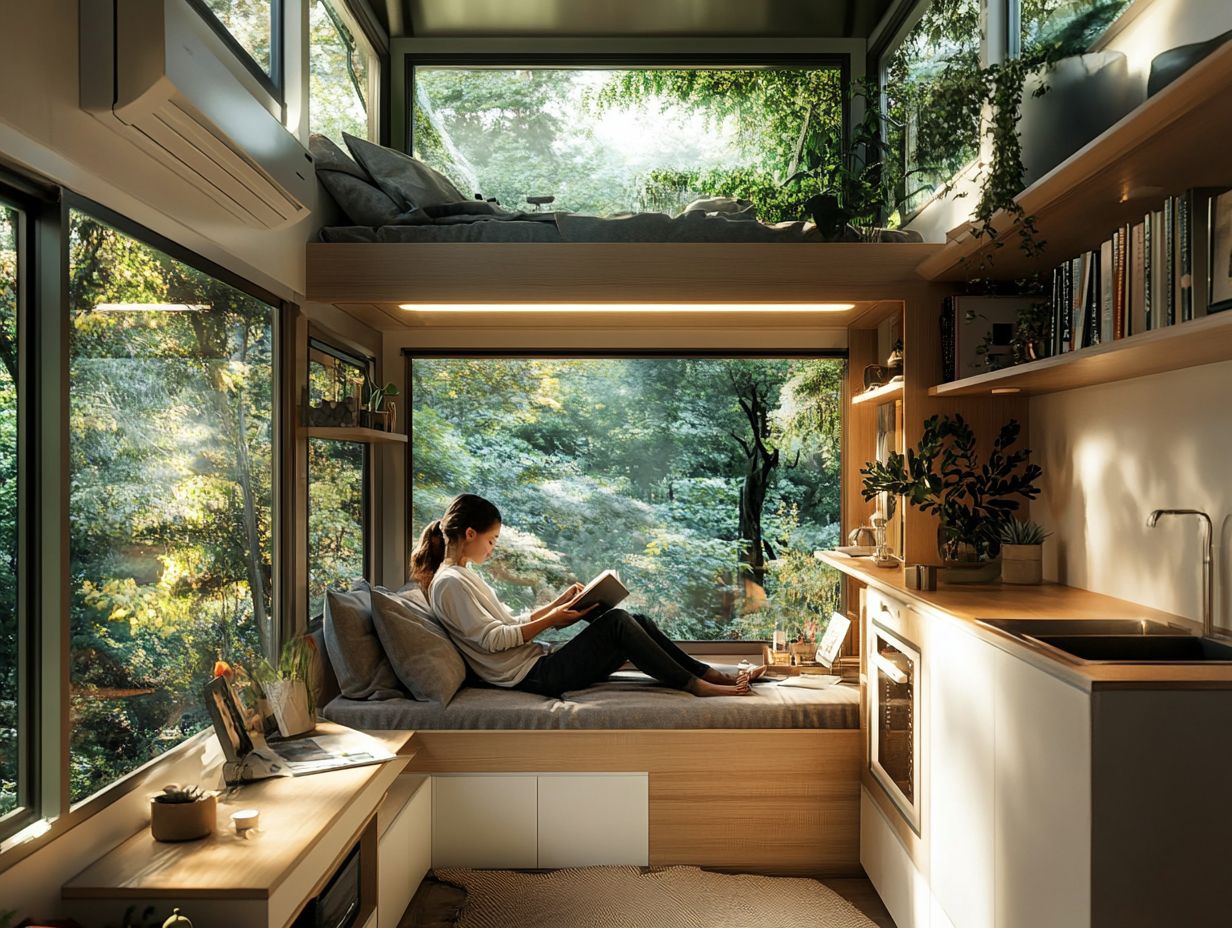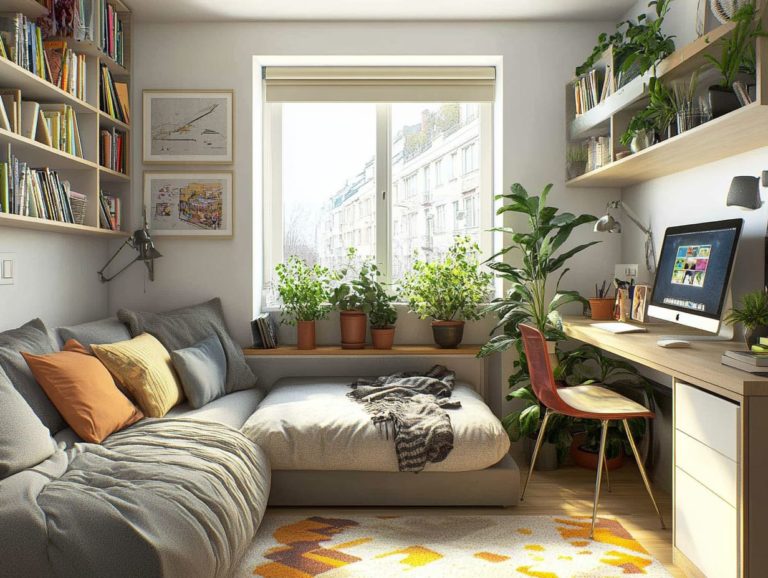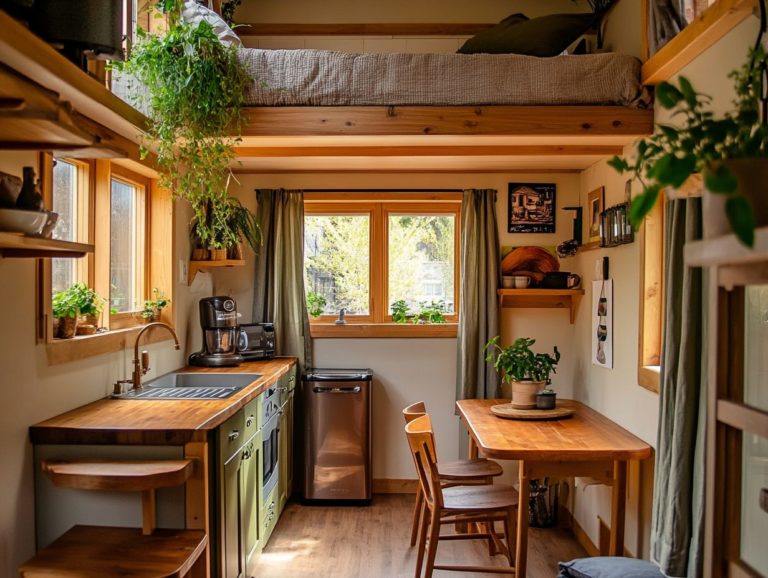Tips for Transitioning to Tiny Living
Tiny living has become an appealing lifestyle choice for those like you who are in search of simplicity, sustainability, and financial freedom.
This concept emphasizes environmental and financial benefits while providing practical guidance for a smooth transition.
From evaluating your needs to crafting a functional space, reducing your possessions, and tackling challenges, this guide walks you through every essential step.
Whether considering a move or intrigued by the idea, explore how embracing tiny living can pave the way to a more fulfilling life.
Contents [hide]
- Key Takeaways:
- What is Tiny Living?
- Benefits of Tiny Living
- Preparing for the Transition
- Designing Your Tiny Space
- Downsizing and Decluttering
- Adjusting to Tiny Living
- Maintaining a Tiny Lifestyle
- Frequently Asked Questions
- How can I ease my transition to tiny living?
- What should I keep in mind when picking a tiny home?
- How do I creatively maximize my tiny home’s space?
- Tips for adjusting to limited storage in a tiny home.
- What are some common challenges when transitioning to tiny living?
- How can I make the most of my outdoor space in a tiny home?
Key Takeaways:

- Assess your needs and wants before transitioning to tiny living to ensure a smooth and successful transition.
- Maximize space and functionality in your tiny home by utilizing creative design and organization techniques.
- Letting go of possessions can be challenging, but it is necessary for a clutter-free and stress-free tiny lifestyle.
What is Tiny Living?
Tiny living embodies a lifestyle choice that embraces minimalism and efficiency. You find yourself drawn to smaller, more sustainable homes often known as tiny houses.
This movement, inspired by the principles of downsizing and simple living, aims to reduce clutter and environmental impact while fostering financial freedom.
Tiny living offers exciting options, from mobile homes to small homes built on the same lot as a larger home, appealing to those seeking a manageable and intentional lifestyle.
With customized tiny homes and accessory dwelling units (ADUs), you can create a living space that reflects your values and aspirations.
Defining the Concept
Understanding tiny living requires grasping its core principles, which center around downsizing and embracing a simpler lifestyle that values experiences over possessions.
This minimalist approach liberates you from the weight of excess belongings and encourages a shift away from consumerism, emphasizing environmental sustainability.
Historically, tiny living has roots in various cultures that thrived in small, efficient homes, reflecting a harmonious relationship with their surroundings.
Today, this lifestyle resonates with those seeking financial freedom and a deeper connection to nature. The tiny living movement aligns with the growing minimalism trend, promoting intentional choices and the pursuit of happiness through meaningful experiences rather than accumulating material goods.
Benefits of Tiny Living
The benefits of tiny living are impressive, offering substantial financial savings and enhancing a sustainable lifestyle. This makes it an attractive option for individuals and families alike.
By embracing a tiny house lifestyle, you can enjoy lower utility costs and a reduced environmental footprint, while connecting with vibrant tiny house communities.
Tiny living simplifies your life, helping you maintain a clutter-free existence and prioritize experiences over material possessions.
Environmental and Financial Advantages
Tiny living presents remarkable environmental and financial benefits that resonate with your desire for a more sustainable and cost-effective lifestyle.
By adopting this minimalist approach, you can significantly reduce your carbon footprint. Smaller homes require fewer materials for construction and consume less energy for heating and cooling, conserving valuable natural resources.
With lower utility bills, your daily expenses become more manageable.
With less space to fill, you’ll find yourself encouraged to declutter, fostering a mindset of conscious consumption and minimizing waste.
Financially, the reduced costs associated with tiny homes can make homeownership attainable, allowing you to channel funds into meaningful experiences or savings instead of oversized mortgages and hefty utility bills.
Ready to transform your life? Dive deeper into tiny living today!
Preparing for the Transition

Transitioning to a tiny house lifestyle requires a thoughtful self-assessment to identify your needs and desires. This prepares you for a smoother downsizing experience. This phase is essential because it lays the groundwork for choosing the perfect tiny house that resonates with your lifestyle preferences and financial objectives.
Carefully consider factors such as space requirements, lifestyle adjustments, and financial impacts. You can navigate the journey toward embracing a minimalist living approach with confidence and clarity.
Assessing Your Needs and Wants
Assessing your needs and wants is a crucial step in your journey to tiny living. It helps clarify what truly matters in your new lifestyle.
Evaluate your lifestyle preferences. Pinpoint which possessions bring you joy or utility, while identifying those that merely take up space. Begin with a comprehensive inventory of your current belongings, allowing you to distinguish essential items from the non-essential ones.
Reflect on your daily routines and what contributes to your overall happiness. Take a straightforward approach by asking yourself key questions about each item’s value and necessity to cultivate a clutter-free and fulfilling living environment.
Designing Your Tiny Space
Designing a tiny space demands both creativity and strategic planning. Maximize every square foot to ensure it serves a purpose! Embrace multipurpose furniture, clever storage solutions, and efficient layouts to significantly enhance the livability of your tiny home.
Check a tiny house guide to learn how to create spaces that serve multiple purposes tailored to your unique needs, while maintaining a sense of style and comfort in your compact living environment. Consider transforming your mindset for tiny house living to enhance your experience.
Maximizing Space and Functionality
Maximizing space and functionality in your tiny home is essential for crafting a comfortable and efficient living environment. Explore techniques that enhance both the aesthetic and practical elements of your space.
Cleverly incorporating multipurpose furniture, like sofa beds or extendable tables, allows you to transition seamlessly between activities, ensuring every inch is utilized effectively. Employ creative storage solutions, such as under-bed compartments and wall-mounted shelving, to minimize clutter and maintain a clean look.
Thoughtful layout considerations, including open-concept designs and the strategic use of vertical space, create an illusion of spaciousness while ensuring essential accessibility and flow throughout your home.
Downsizing and Decluttering
Downsizing and decluttering are key steps! Start shedding those extra things now to cultivate a more organized lifestyle. By using effective ways to declutter, like the KonMari technique, you can thoughtfully assess your belongings and make deliberate choices about what to keep.
This streamlining simplifies your moving process. It nurtures clarity and tranquility as you transition to your new tiny home.
Tips for Letting Go of Possessions

Letting go of possessions can be both a daunting and liberating experience as you transition to tiny living, especially when you’re part of a supportive tiny house community.
Start by setting clear, achievable goals that break down the decluttering process into manageable tasks. You might choose to tackle one room at a time or focus on specific categories of items, such as clothing or kitchen gadgets.
Establishing a sorting system lends structure to your efforts. Designate boxes or areas for items you wish to keep, donate, or discard, streamlining your decision-making process. Once you’ve sorted through the unwanted items, finding new homes for them whether through donations, sales, or online reselling can bring you joy and benefit others, ensuring that what no longer serves a purpose is appreciated anew.
Adjusting to Tiny Living
Adjusting to the tiny home lifestyle brings its own unique challenges that demand adaptability and a proactive mindset. However, within the welcoming tiny house community, countless solutions await.
As you embark on this journey, you might face issues like limited space, the necessity for careful organization, and changes to your daily habits that can initially seem overwhelming. Yet, with the right strategies and support, you can successfully navigate these obstacles. Consider checking out some tips for visiting tiny house communities to help you truly thrive in your new living environment.
Challenges and Solutions
The transition to tiny living can indeed pose a range of challenges, but recognizing these obstacles gives you the power to devise effective solutions.
Navigating limited space and adjusting your lifestyle to embrace a more minimalist approach often comes with a steep learning curve. Financial considerations also weigh heavily, as many individuals aim to downsize without sacrificing their quality of life.
You can find many community resources that offer valuable guidance on smart storage solutions and budgeting tips.
Joining the tiny house community opens up a world of support and inspiration! Engaging with fellow tiny living enthusiasts can help you build a supportive network where experiences and practical advice are freely shared, ultimately making your journey toward a simpler, more fulfilling lifestyle considerably smoother.
Maintaining a Tiny Lifestyle
Maintaining a tiny lifestyle requires a steadfast commitment to living in a way that is good for the environment and future generations and effective home organization, setting the stage for long-term success in your tiny home journey.
By establishing routines for decluttering, embracing minimalist principles, and actively engaging with the tiny house community, you can fully embrace the myriad benefits this lifestyle offers.
For sustained success, consider regularly assessing your belongings and remaining mindful of your consumption habits. This intentional approach not only enhances your living space but also enriches your overall experience.
Tips for Long-Term Success
Achieving long-term success in tiny living requires your ongoing commitment to the principles of sustainable living and effective home organization.
By establishing a consistent routine for decluttering, you can ensure that your limited space remains both functional and enjoyable. Regularly assessing your belongings perhaps on a monthly basis encourages a mindset of mindful consumption.
Embracing this approach means being intentional about your purchases, selecting quality items that genuinely add value to your life. Staying connected with others who share this lifestyle, whether through social media or local meet-ups, can provide both inspiration and support.
Engaging with the vibrant tiny house community not only strengthens your connections but also offers fresh perspectives and motivation for maintaining a minimalist yet fulfilling lifestyle. Start implementing these tips today for a happier tiny living experience!
Frequently Asked Questions

How can I ease my transition to tiny living?
One tip for transitioning to tiny living is to downsize and declutter before moving into your tiny home. This will help you get used to living with less space and make the actual move less overwhelming.
What should I keep in mind when picking a tiny home?
When choosing a tiny home, you should consider the size, layout, and features that are most important to you. You should also think about the location and any zoning or building regulations that may impact your living situation.
How do I creatively maximize my tiny home’s space?
There are many creative ways to maximize space in a tiny home, such as using multi-functional furniture, utilizing vertical space, and implementing storage solutions like under-bed storage or built-in shelving.
Tips for adjusting to limited storage in a tiny home.
Adjusting to limited storage in a tiny home can be challenging, but it’s important to prioritize and only keep items that are essential or bring you joy. You can also utilize storage solutions like hanging organizers or utilizing wall space for additional storage.
What are some common challenges when transitioning to tiny living?
Some common challenges when transitioning to tiny living include adjusting to a smaller living space and dealing with limited storage and amenities.
Navigating local building rules can also be tricky. It’s essential to prepare for this significant lifestyle change.
How can I make the most of my outdoor space in a tiny home?
Making the most of your outdoor space in a tiny home is essential! You can create a cozy spot for relaxation surrounded by nature.
Add plants and set up a small seating area. Consider using vertical space for storage or decoration to maximize your outdoor experience.





